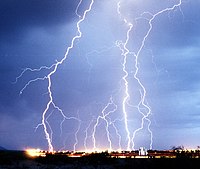
Photo from wikipedia
In this work, a Particle in Cell-Monte Carlo Collision simulation technique is used to study the operating parameters of a typical helicon plasma source. These parameters mainly include the gas… Click to show full abstract
In this work, a Particle in Cell-Monte Carlo Collision simulation technique is used to study the operating parameters of a typical helicon plasma source. These parameters mainly include the gas pressure, externally applied static magnetic field, the length and radius of the helicon antenna, and the frequency and voltage amplitude of the applied RF power on the helicon antenna. It is shown that, while the strong radial gradient of the formed plasma density in the proximity of the plasma surface is substantially proportional to the energy absorption from the existing Trivelpiece-Gould (TG) modes, the observed high electron temperature in the helicon source at lower static magnetic fields is significant evidence for the energy absorption from the helicon modes. Furthermore, it is found that, at higher gas pressures, both the plasma electron density and temperature are reduced. Besides, it is shown that, at higher static magnetic fields, owing to the enhancement of the energy absorption by the plasma charged ...
Journal Title: Physics of Plasmas
Year Published: 2018
Link to full text (if available)
Share on Social Media: Sign Up to like & get
recommendations!